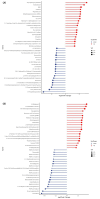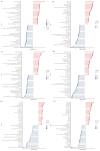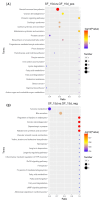Effects of perinatal nutrition supplementation and early weaning on serum biochemistry, metabolomics, and reproduction in yaks
- PMID: 39748870
- PMCID: PMC11694451
- DOI: 10.3389/fvets.2024.1443856
Effects of perinatal nutrition supplementation and early weaning on serum biochemistry, metabolomics, and reproduction in yaks
Abstract
The transition period is a crucial stage in the reproductive cycle for dams and is linked closely with postpartum recovery, reproduction performance, and health. The confronting problem in the yak industry is that transition yaks under a conventional grazing feeding regime endure nutritional deficiency since this period is in late winter and early spring of the Qinghai-Tibet Plateau with the lack of grass on natural pasture. Therefore, this study aimed to investigate the effects of perinatal nutritional supplementation and early weaning on serum biochemistry, reproductive performance, and metabolomics in transition yaks. Eighteen healthy yaks in late pregnancy (233.9 ± 18.3 kg, 2-4 parity) were randomly assigned to three groups: conventional grazing feeding (GF, n = 6), additional nutrition supplementation (SF, n = 6), and additional nutrition supplementation with early weaning (SW, n = 6). Yaks in the GF, SF, and SW groups were free grazing on the same pasture in the daytime from -30 to 90 d relative to parturition. Yaks in SF and SW groups received total mixed ration supplementation in the barn during the night throughout the trial. Calves in the SW group were early weaned and separated from the dam at 60 d postpartum. Maternal body weight was measured at -30 and 90 d, and serum samples were collected to analyze serum biochemistry, hormones, and metabolomics at -15, 30, and 90 d relative to calving. In the SF and SW groups, yaks showed significantly higher body weight gain, serum glucose, globulin, and total protein concentrations. Lipid transportation molecules apolipoprotein B100 and very low-density lipoprotein of SF and SW yaks were significantly increased along with the decreased lipid mobilization products non-esterified fatty acid and β-hydroxybutyric acid when compared to GF yaks at -15 and 30 d. At 90 d, serum non-esterified fatty acid and β-hydroxybutyric acid levels were significantly lower in SW yaks than in SF ones, while apolipoprotein B100 and very low-density lipoprotein levels were significantly higher in SW yaks than in GF yaks. The serum levels of metabolic regulatory hormones, including insulin, leptin, and insulin-like growth factor I were significantly increased, and glucagon was significantly reduced in the SF and SW groups than in the GF group at -15 and 30 d. Among serum reproductive hormones, SF and SW yaks had significantly higher estradiol and progesterone concentrations than GF ones at -15 and 30 d. Follicle-stimulating and luteinizing hormone levels were increased in SW group than in SF and GF ones at 90 d. The calving rates in the following year were 0% (GF), 16.7% (SF), and 83.3% (SW), respectively. The serum metabolomics analysis revealed 848 metabolites in positive mode and 350 in negative mode. With the perinatal nutritional supplementation, the lipid and energy metabolism of transition yaks were improved, meanwhile, lipid mobilization and estrogen production-related pathways were down-regulated. These data suggest that perinatal nutrition supplementation reduces body weight loss, improves glucose and lipid metabolic adaptation to the transition period, and improves yaks' reproductive performance. Additionally, the combination of early weaning and nutritional supplementation results in lower lipid mobilization and up-regulation of lipid transportation and reproductive hormone secretion, which may further contribute to postpartum recovery and acceleration of the reproductive cycle.
Keywords: metabolomics; nutritional supplementation; perinatal period; serum biochemistry; yak.
Copyright © 2024 Shang, Guan, An, Zhao, Bai, Li, Sha, Jiang, Zhang and Luo.
Conflict of interest statement
The authors declare that the research was conducted in the absence of any commercial or financial relationships that could be construed as a potential conflict of interest.
Figures







Similar articles
-
Metabonomic Responses of Grazing Yak to Different Concentrate Supplementations in Cold Season.Animals (Basel). 2020 Sep 8;10(9):1595. doi: 10.3390/ani10091595. Animals (Basel). 2020. PMID: 32911680 Free PMC article.
-
The Effects of Postpartum Yak Metabolism on Reproductive System Recovery.Metabolites. 2022 Nov 15;12(11):1113. doi: 10.3390/metabo12111113. Metabolites. 2022. PMID: 36422253 Free PMC article.
-
Reproduction in female yaks (Bos grunniens) and opportunities for improvement.Theriogenology. 2003 Mar;59(5-6):1303-12. doi: 10.1016/s0093-691x(02)01172-x. Theriogenology. 2003. PMID: 12527077 Review.
-
Effect of strategic feed supplementation on productive and reproductive performance in yak cows.Prev Vet Med. 1999 Jan 27;38(2-3):195-206. doi: 10.1016/s0167-5877(98)00125-1. Prev Vet Med. 1999. PMID: 10081799
-
"The Yak"-A remarkable animal living in a harsh environment: An overview of its feeding, growth, production performance, and contribution to food security.Front Vet Sci. 2023 Feb 2;10:1086985. doi: 10.3389/fvets.2023.1086985. eCollection 2023. Front Vet Sci. 2023. PMID: 36814466 Free PMC article. Review.
Cited by
-
Evaluating the Effect of Dietary Protein-Energy Ratios on Yak Intestinal Microbiota Using High-Throughput 16S rRNA Gene Sequencing.Vet Sci. 2025 Mar 1;12(3):208. doi: 10.3390/vetsci12030208. Vet Sci. 2025. PMID: 40266935 Free PMC article.
-
Active dry yeast enhances immunity through modulation of gut microbiota and serum metabolic processes in captive forest musk deer (Moschus berezovskii).BMC Vet Res. 2025 Apr 12;21(1):262. doi: 10.1186/s12917-025-04705-z. BMC Vet Res. 2025. PMID: 40221712 Free PMC article.
References
-
- Iqbal Yatoo M, Shabir M, Kubrevi SS, Dar RA, Angmo K, Kanwar MS, et al. . A study on biological rhythms of Himalayan yaks. Biol Rhythm Res. (2020) 51:1087–94. doi: 10.1080/09291016.2019.1579883 - DOI
LinkOut - more resources
Full Text Sources

